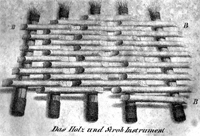Difference Between Xylophone and Glockenspiel
 Xylophone vs Glockenspiel
Xylophone vs Glockenspiel
Both the xylophone and glockenspiel are instruments belonging to the family of percussion musical instruments. However, the difference ends there. Their origins, bars and octaves are highly different. Despite these differences and probably owing to these differences, both of them have secured an honorable position in orchestral symphonies.
The origins of the xylophone can be traced back to ancient Africa ‘“ the earliest written account of the xylophone is around the 14th century in Mali, Africa. There were various types of xylophones ‘“ some simple bars of woods without having any resonators and some highly complex xylophones that are framed and also have hollowed gourds that function as resonators.
The glockenspiel originated in Germany wherein churches used a set of fixed bells by hand. The bells were then replaced by steel bars around the 17th century. Later, the steel bars became an integral part of the glockenspiel.
The main difference between the xylophone and glockenspiel is that the bars of the xylophone are wooden whereas the bars in the glockenspiel are made of steel. Hence their names, glockenspiel and xylophone ‘“ glock in Germany refers to ‘bells’ whereas xylos in xylophone refers to ‘wood’. The wooden bars of the xylophone are generally made out of rosewood ‘“ this could be the light rosewood, padauk or rosewood from Honduras. Xylophones made out of Honduras rosewood is considered to produce the best sound.
The xylophone is considered to have a high pitch sound which is sharp and short and the glockenspiel is considered to have a higher pitch than that of the xylophone due to its metallic nature.
The xylophone can be anywhere between three octaves to four octaves, the most common and popular being the version carrying 3.5 octaves. The glockenspiel is usually between 2.5-3 octaves.
The glockenspiel is always written two octaves lower than actual in music notes whereas in a xylophone it will always sound one octave higher than what is written in the notes.
With respect to size, the glockenspiel is much smaller than the xylophone.
Summary:
1. As the name suggests, the bars of the xylophone is made of xylos or wood whereas the bars in a glockenspiel are made of steel ‘“ glock means bells in German
2. The xylophone is supposed to have originated in Africa and the glockenspiel is supposed to have come from Germany
3. The glockenspiel has a higher pitch and sound than the xylophone.
4. The xylophone has a range of 3-4 octaves whereas the xylophone has a range of 2.5-3 octaves
5. The glockenspiel will sound two pitches higher due to which music notes are always written two octaves lower for the glockenspiel. On the other hand, the xylophone will sound one octave higher than what is written in the music notes.
6. The glockenspiel is smaller in size when compared to the xylophone.
- Difference Between Schizophrenia and Psychosis - March 7, 2024
- Difference Between African and Asian Elephants - March 7, 2024
- Difference Between Sunscreen and Sunblock - February 15, 2024
Search DifferenceBetween.net :
 Email This Post
: If you like this article or our site. Please spread the word. Share it with your friends/family.
Email This Post
: If you like this article or our site. Please spread the word. Share it with your friends/family.


Great article. One thing needs correction, a xylophone sounds one octave higher, not one pitch.